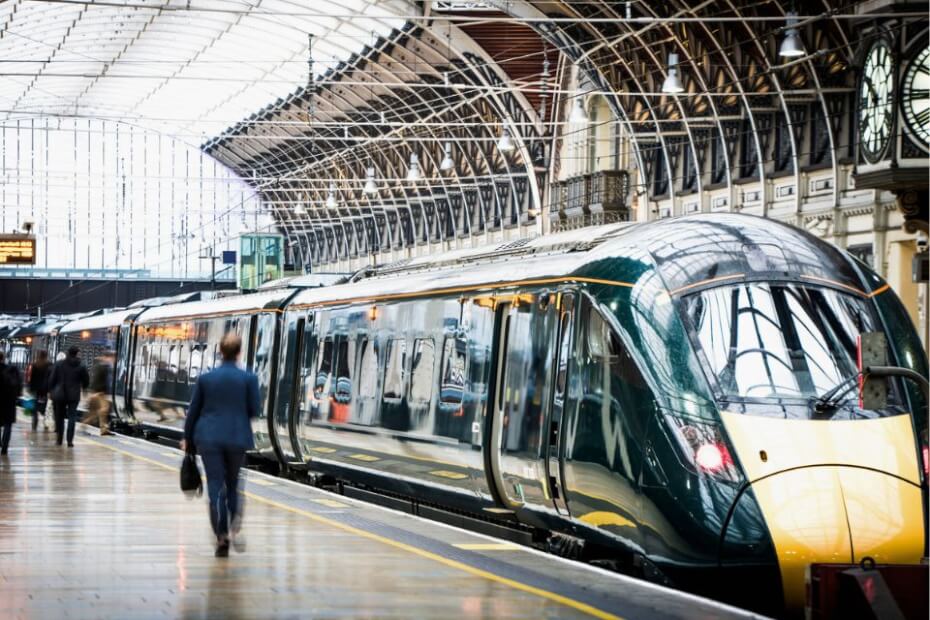
Train travel in the United Kingdom (UK) is one of the best ways to explore the country’s charming cities, scenic countryside, and historic landmarks.
Its railway network and modern international connections deliver convenient and enjoyable train journeys for all visitors.
Rail travel is also a popular vacation for all ages, offering easy access to European countries and stopping at different places to explore. While the UK is no longer part of the European Union (EU), it is still very much connected by train.
This guide covers everything you need to know for train travel in the UK, including routes and tips to essential travel documents like the new Electronic Travel Authorization (ETA).
Why train travel is popular in the UK
The UK has one of the world’s oldest and most comprehensive railway systems, dating back to the 19th century. Traveling by train is an efficient, environmentally friendly, and scenic way to get around.
Here are a few reasons why train travel is so popular:
- Convenience: Train stations are located in city centers, making them easily accessible.
- Speed: High-speed trains connect major cities like London, Edinburgh, and Manchester, reducing travel times.
- Scenic Views: Regional and scenic rail routes allow travelers to see the UK’s picturesque landscapes.
- Sustainability: Trains are a greener alternative to cars and planes, with many running on electric power.
International rail connections to the UK
Although the UK is an island, it’s well-connected to mainland Europe by train, thanks to the Channel Tunnel, also known as the “Chunnel.”
The Chunnel, which runs under the English Channel, ranks as the third-longest railway tunnel in the world. It is almost 32 miles (51 km) long and sits 377 feet (115 meters) below sea level at its lowest point.
It carries passenger and freight trains and a roll-on roll-off shuttle service for road vehicles and private cars.
The Chunnel terminals are located at Coquelles near Calais in France and Cheriton near Folkestone in England. These terminals mainly serve freight and vehicles, but passengers can also travel to London or Paris.
Eurostar is the high-speed train service that links London with several European cities via the Chunnel. Here are some key routes:
- Paris to London: Approximately two hours and 15 minutes, departing from Gare du Nord and arriving at St. Pancras International.
- Brussels to London: Also around two hours, departing from Brussels Midi/Zuid.
- Amsterdam to London: About four hours and offers a convenient link to the Netherlands.
St. Pancras International, the London terminal, is a central hub connecting to other UK cities.
Navigating the UK rail network

The UK’s rail network covers England, Scotland, Wales, and Northern Ireland. Services are operated by various companies under the National Rail umbrella, offering a wide range of routes.
High-speed trains
High-speed trains provide fast and frequent service between major cities. For example:
- Avanti West Coast links London to Manchester, Birmingham, and Glasgow.
- LNER operates on the East Coast Main Line, connecting London with Edinburgh, Leeds, and Newcastle.
These trains are modern and equipped with amenities like Wi-Fi and charging outlets.
Regional and scenic routes
The UK also has an extensive network of regional trains serving smaller towns and rural areas. For travelers looking for scenic journeys, these routes stand out:
- The West Highland Line: This Scottish route travels from Glasgow to Mallaig, passing lochs, mountains, and the famous Glenfinnan Viaduct.
- The Settle-Carlisle Line: A picturesque journey through the Yorkshire Dales and Cumbrian Fells featuring stunning Victorian architecture.
- The Cornish Riviera Express: Connecting London to Penzance, this route offers breathtaking views of the south coast.
The UK’s scenic train routes are a highlight for many travelers, so it’s wise to book in advance during peak travel seasons. Here are a few must-try experiences:
- The Jacobite Steam Train: Known as the “Hogwarts Express” from the Harry Potter films, this train runs through the Scottish Highlands.
- Snowdon Mountain Railway: This narrow-gauge railway climbs to the summit of Snowdon, the highest peak in Wales.
- The Heart of Wales Line: A rural route showcasing mid-Wales’ unspoiled countryside.
Tips for smooth train travel in the UK
To make your train travel experience in the UK as smooth as possible, keep these tips in mind:
- Book in advance: Train tickets are often cheaper when purchased weeks ahead of travel dates. Look for advance fares on websites like National Rail or Trainline.
- Confirm onboard services: High-speed trains often feature food and drink options, Wi-Fi, and comfortable seating. Major train stations and services also have accessibility options for passengers with mobility needs. Assistance can be arranged in advance.
- Pack light. Most UK trains have no strict baggage policy limits. Still, travelers should pack light to avoid difficulties boarding or storing luggage.
- Travel off-peak: Avoid traveling during peak hours (6:30 to 9:30 AM and 4:30 to 7:00 PM on weekdays) for lower fares and fewer crowds.
- Rail passes for visitors: Those who plan to travel extensively should consider a BritRail Pass, which offers unlimited travel on consecutive days across the UK.
- Use rail apps: Apps like National Rail Enquiries provide live updates, platform information, and ticket booking options.
- Check for delays: Service disruptions are uncommon but can occur due to weather or maintenance. Always check train schedules on the day of travel.
The UK ETA and post-Brexit train travel considerations
The UK and the EU have maintained visa reciprocity post-Brexit. This means that British and European nationals can still enjoy cross-channel travel without the need for visas for short visits. Customs checks are also in place, especially for goods and duty-free items.
UK-bound travelers must also have the required travel documentation before boarding or arriving in the UK by train. In 2025, this includes the new UK ETA scheme for non-visa travelers‘ short trips of less than six months.
Similarly, in 2025, the EU will launch its own similar electronic pre-travel authorization system, the European Travel Information and Authorization System (ETIAS). This applies to visa-exempt travelers, including British citizens, visiting the EU for short trips.
The UK ETA and the EU’s ETIAS are designed to improve border security and streamline travel. While they are not visas, travelers must apply for pre-travel authorization before their trip.
UK ETA implementation and application process

Starting 8 January 2025, all visa-exempt non-European UK visitors must have an ETA before their journey. Applications open for European nationals on 5 March 2025 for travels to the UK on and after 2 April 2025.
Applying for an ETA is easy as it can be done entirely online via the UK Government website or the UK ETA mobile app. Travelers only need a valid passport and email address, a recent passport photo, and online payment via credit or debit card, Apple Pay, or Google Pay.
Applicants must complete an online application form, which includes answering security questions and paying the £10 application fee. Processing typically takes three days, but there may be cases where it would take longer. Travelers are advised to apply well before their intended travel to avoid delays.
The ETA will be electronically linked to travelers’ passports. It will be valid for two years unless the passport linked to it expires earlier. During this period, ETA holders can travel to the UK multiple times for short stays or up to six months per visit.
Visa-required travelers and those denied an ETA must apply for a UK visa to visit England. The same applies to those planning to work, study for more than six months, and live in the UK. The UK ETA scheme does not affect the UK visa application system.

